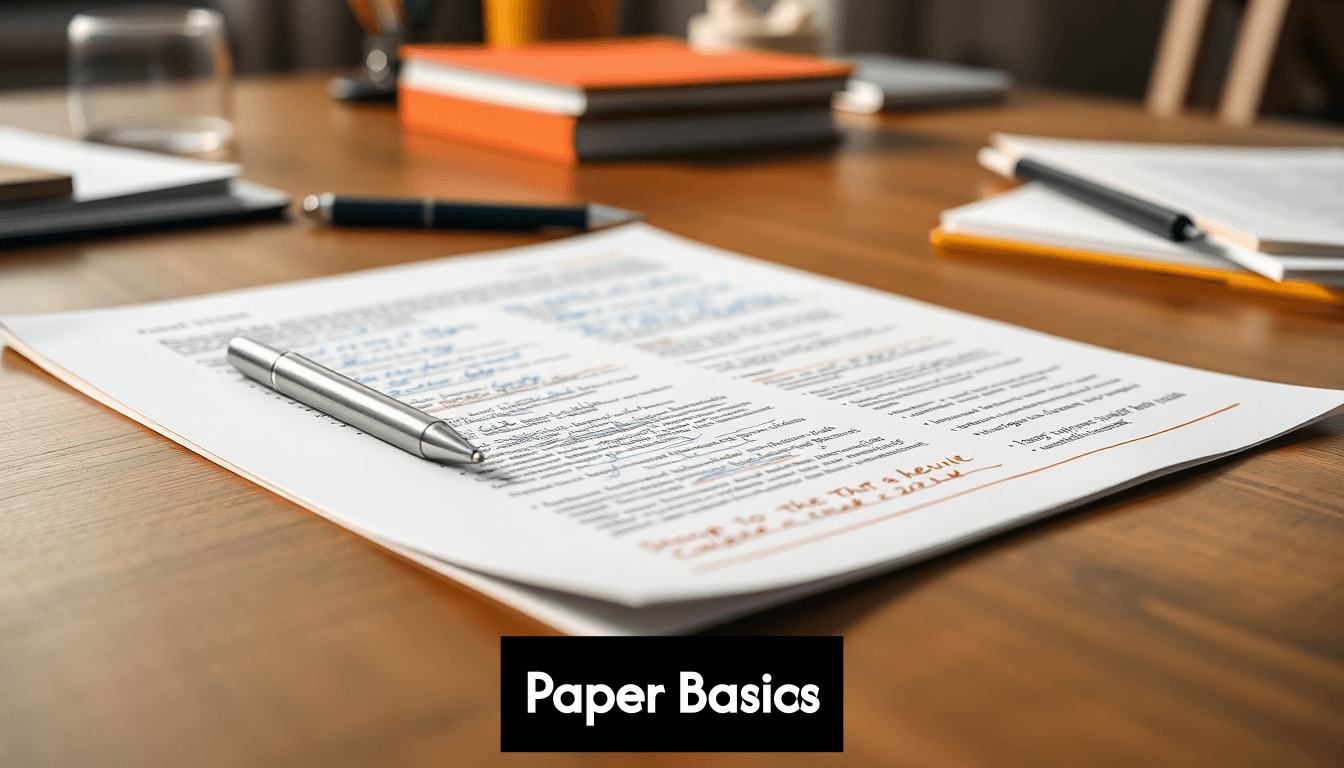Blog
Learning Materials
2025년 과학 논문 작성에 대한 완벽한 가이드
Updated: May 5, 2025

학술 논문은 학문적 소통의 생명선으로, 연구자들이 통찰과 발견을 공유할 수 있는 엄격한 방법을 제공합니다. 하지만 여기서 중요한 점은, 학술 저널에 제출된 논문 중 약 35%만이 출판된다는 것입니다. 따라서 이 기술을 마스터하는 것이 성공의 열쇠입니다. 진짜 반전은? 단순히 잘 쓰는 것만이 아니라, 설득력 있는 논문 작성에서부터 인용 스타일을 이해하는 것까지, 전체 구조를 이해하는 것이 당신의 작업을 한 단계 끌어올릴 수 있다는 것입니다.
목차
- 학술 논문의 기본 이해 Dockerfile README.md email-templates i18n-config.ts i18nConfig.ts next-sitemap-samwell.config.js next-sitemap-semihuman.config.js next.config.js node_modules package-lock.json package.json process_content.js public scripts src svgr.d.ts translations tsconfig.json 학술 논문이란 무엇인가 Dockerfile README.md email-templates i18n-config.ts i18nConfig.ts next-sitemap-samwell.config.js next-sitemap-semihuman.config.js next.config.js node_modules package-lock.json package.json process_content.js public scripts src svgr.d.ts translations tsconfig.json 일반적인 학술 논문 유형 Dockerfile README.md email-templates i18n-config.ts i18nConfig.ts next-sitemap-samwell.config.js next-sitemap-semihuman.config.js next.config.js node_modules package-lock.json package.json process_content.js public scripts src svgr.d.ts translations tsconfig.json 학술 논문의 기본 구조
- 핵심 구조 및 형식 Dockerfile README.md email-templates i18n-config.ts i18nConfig.ts next-sitemap-samwell.config.js next-sitemap-semihuman.config.js next.config.js node_modules package-lock.json package.json process_content.js public scripts src svgr.d.ts translations tsconfig.json 제목 페이지 및 초록 Dockerfile README.md email-templates i18n-config.ts i18nConfig.ts next-sitemap-samwell.config.js next-sitemap-semihuman.config.js next.config.js node_modules package-lock.json package.json process_content.js public scripts src svgr.d.ts translations tsconfig.json 서론 및 논문 진술 Dockerfile README.md email-templates i18n-config.ts i18nConfig.ts next-sitemap-samwell.config.js next-sitemap-semihuman.config.js next.config.js node_modules package-lock.json package.json process_content.js public scripts src svgr.d.ts translations tsconfig.json 본문 단락 및 섹션 제목 Dockerfile README.md email-templates i18n-config.ts i18nConfig.ts next-sitemap-samwell.config.js next-sitemap-semihuman.config.js next.config.js node_modules package-lock.json package.json process_content.js public scripts src svgr.d.ts translations tsconfig.json 인용 및 참고 문헌 목록 Dockerfile README.md email-templates i18n-config.ts i18nConfig.ts next-sitemap-samwell.config.js next-sitemap-semihuman.config.js next.config.js node_modules package-lock.json package.json process_content.js public scripts src svgr.d.ts translations tsconfig.json 형식 규칙
- 유형, 요소 및 방법론 Dockerfile README.md email-templates i18n-config.ts i18nConfig.ts next-sitemap-samwell.config.js next-sitemap-semihuman.config.js next.config.js node_modules package-lock.json package.json process_content.js public scripts src svgr.d.ts translations tsconfig.json 확장된 학술 논문 유형 Dockerfile README.md email-templates i18n-config.ts i18nConfig.ts next-sitemap-samwell.config.js next-sitemap-semihuman.config.js next.config.js node_modules package-lock.json package.json process_content.js public scripts src svgr.d.ts translations tsconfig.json 학술 논문 전반의 주요 요소 Dockerfile README.md email-templates i18n-config.ts i18nConfig.ts next-sitemap-samwell.config.js next-sitemap-semihuman.config.js next.config.js node_modules package-lock.json package.json process_content.js public scripts src svgr.d.ts translations tsconfig.json 학술 글쓰기의 연구 방법론
- 초안 작성, 수정 및 인용 Dockerfile README.md email-templates i18n-config.ts i18nConfig.ts next-sitemap-samwell.config.js next-sitemap-semihuman.config.js next.config.js node_modules package-lock.json package.json process_content.js public scripts src svgr.d.ts translations tsconfig.json 초안 작성 과정 Dockerfile README.md email-templates i18n-config.ts i18nConfig.ts next-sitemap-samwell.config.js next-sitemap-semihuman.config.js next.config.js node_modules package-lock.json package.json process_content.js public scripts src svgr.d.ts translations tsconfig.json 수정 과정 Dockerfile README.md email-templates i18n-config.ts i18nConfig.ts next-sitemap-samwell.config.js next-sitemap-semihuman.config.js next.config.js node_modules package-lock.json package.json process_content.js public scripts src svgr.d.ts translations tsconfig.json 효과적인 인용 관행
간단 요약
| 요점 | 설명 |
|---|---|
| 학술 논문의 특성 이해 | 학술 논문은 증거 기반의 논리, 구조화된 조직, 공식적인 언어, 적절한 인용을 요구하는 공식 문서로, 신뢰할 수 있는 통찰을 전달하고 학문적 담론에 기여합니다. |
| 명확한 구조 따르기 | 대부분의 학술 논문은 독자의 이해와 효과적인 논증을 돕기 위해 서론, 문헌 검토, 방법론, 결과, 논의, 결론을 포함하는 표준 구조를 따라야 합니다. |
| 적절한 형식 및 인용 활용 | 특정 형식 규칙과 인용 스타일(APA, MLA, IEEE 등)을 준수하면 연구를 전문적으로 제시할 뿐만 아니라 학문적 무결성을 보장하고 독자가 출처를 찾는 데 도움을 줍니다. |
| 초안 작성 및 수정 과정 수용 | 글쓰기는 반복적입니다. 구조화된 개요로 시작하고 여러 단계의 초안 작성과 수정을 수용하면 최종 원고의 명확성과 깊이를 향상시킬 수 있습니다. |
| 적절한 방법론 선택 | 연구 질문과 학문적 기준에 따라 양적, 질적, 혼합 방법, 참여 연구와 같은 적절한 연구 방법론을 선택하여 효과적으로 탐구를 안내하십시오. |
학술 논문의 기본 이해

학술 논문은 학문적 소통의 초석으로, 연구자와 학생들이 발견을 공유하고 개념을 분석하며 그들의 분야에 지식을 기여할 수 있게 합니다. 학술 논문을 효과적으로 만드는 기본을 이해하는 것은 학문 공동체의 누구에게나 필수적입니다.
학술 논문이란 무엇인가?
학술 논문은 증거와 학문적 출처를 기반으로 한 원본 연구, 분석 또는 주장을 제시하는 공식 문서입니다. 일반적인 글쓰기와 달리, 학술 논문은 명확성, 신뢰성, 유용성을 보장하기 위해 발전된 특정 구조, 톤, 문서화 규칙을 따릅니다.
학술 논문의 주요 목적은 비판적 사고와 체계적인 조사를 통해 지식을 발전시키는 것입니다. 학부생이 첫 번째 연구 논문을 작성하든, 출판을 준비하는 교수이든, 학술 논문이 무엇을 정의하는지 이해하는 것은 당신의 작업을 신뢰할 수 있고 가치 있게 만듭니다.
학술 논문은 일반적으로 몇 가지 주요 특성을 공유합니다:
- 증거 기반의 논리 - 주장은 데이터, 인용 또는 논리적 논증으로 뒷받침됩니다.
- 구조화된 조직 - 내용은 명확한 섹션으로 구성된 표준 프레임워크를 따릅니다.
- 공식적인 언어 - 글쓰기는 객관적이고 정확하며 적절한 용어를 유지합니다.
- 적절한 인용 - 출처는 일관된 인용 스타일을 사용하여 인정됩니다.
일반적인 학술 논문 유형
학술 글쓰기는 학문적 소통 내에서 다양한 목적을 제공하는 여러 문서 유형을 포함합니다:
연구 논문은 경험적 연구 또는 이론적 분석에서 얻은 원본 발견을 제시합니다. 이러한 논문은 일반적으로 연구 질문에서 방법론, 결과 및 논의로 이어지는 과학적 방법을 따릅니다.
문헌 검토는 주제에 대한 기존 연구를 종합하고 평가하여 연구 간의 패턴, 격차 및 관계를 식별합니다. 새로운 데이터를 제시하는 대신, 문헌 검토는 이미 알려진 것을 조직하고 해석함으로써 가치를 창출합니다.
사례 연구는 특정 사례, 사건 또는 주제를 자세히 조사하여 더 넓은 원칙을 설명하거나 새로운 통찰을 개발합니다. 이 접근법은 특히 비즈니스, 의학 및 사회 과학에서 일반적입니다.
에세이는 비판적 사고와 분석을 통해 주제에 대한 논쟁이나 관점을 발전시킵니다. 학술 에세이는 개인적 반성보다는 증거와 학문적 참여에 의존하여 개인 에세이와 다릅니다.
실험 보고서는 과학 실험을 문서화하여 방법, 관찰 및 결론을 포함합니다. 이러한 구조화된 문서는 다른 연구자들이 실험을 이해하고 잠재적으로 재현할 수 있도록 보장합니다.
학술 논문의 기본 구조
분야와 논문 유형에 따라 변형이 존재하지만, 대부분의 학술 논문은 저자의 사고 과정을 독자에게 안내하기 위해 설계된 유사한 전체 구조를 따릅니다:
서론은 주제의 중요성을 설정하고 필요한 배경을 제공하며 연구 질문이나 논문을 제시하고 이후 내용을 개요합니다. 강력한 서론은 독자들이 왜 이 주제에 관심을 가져야 하는가?라는 중요한 질문에 답합니다.
문헌 검토는 관련 연구를 요약하여 현재 작업을 기존 학문 내에 위치시킵니다. 이 섹션은 저자의 분야에 대한 지식을 보여주고 현재 논문의 필요성을 정당화합니다.
방법론은 저자가 정보를 수집하고 분석한 방법을 설명합니다. 방법의 투명성은 독자가 발견의 타당성을 평가하고 연구를 잠재적으로 재현할 수 있도록 합니다.
결과는 해석 없이 발견을 제시하며, 종종 데이터를 효과적으로 전달하기 위해 차트, 표 또는 기타 시각적 보조 도구를 사용합니다.
논의는 결과를 해석하고, 그 중요성을 검토하며, 제한점을 다루고, 이론이나 실천에 대한 함의를 제안합니다.
결론은 주요 포인트를 요약하고 향후 연구 방향을 제안할 수 있습니다.
이 기본을 이해하면 학술 논문을 효과적으로 읽고 작성하는 데 기초를 제공합니다. 학술 논문에 대한 특정 요구 사항은 분야, 기관 및 글쓰기의 특정 목적에 따라 다르지만, 이러한 기본 원칙은 분야 전반에 걸쳐 널리 적용되며 학문적 소통을 위한 공통 언어를 만듭니다.
학술 논문 작성의 기본을 마스터하는 것은 단순히 규칙을 따르는 것이 아닙니다. 이는 당신의 연구 분야에서 지식을 발전시키는 지속적인 대화에 참여하는 방법을 배우는 것입니다.
핵심 구조 및 형식
적절한 구조와 형식은 학술적 아이디어를 읽기 쉽고 전문적인 문서로 변환하여 학문적 기준을 충족시킵니다. 이전 섹션에서는 학술 논문의 일반적인 구성 요소를 소개했지만, 이 섹션에서는 학술 논문에 특유의 외관과 흐름을 부여하는 특정 형식 규칙과 조직 요소를 살펴봅니다.
제목 페이지 및 초록
학술 논문 여정은 제목 페이지에서 시작됩니다—당신의 작업의 첫인상입니다. 표준 제목 페이지에는 논문의 제목, 이름, 소속 기관, 강의 정보, 교수 이름, 제출 날짜가 포함됩니다. 제목 자체는 간결하면서도 설명적이어야 하며, 일반적으로 논문의 내용을 정확하게 반영하고 독자의 관심을 끌 수 있는 10-15 단어로 구성됩니다.
제목 페이지 다음으로 대부분의 학술 논문에는 150-250 단어로 요약된 초록이 포함됩니다. 초록은 논문의 엘리베이터 피치로 생각하십시오. 연구 질문, 방법론, 주요 발견 및 결론에 대한 빠른 개요를 제공합니다. 그 짧은 길이에도 불구하고, 초록은 누군가가 전체 논문을 읽을지 여부를 결정하는 데 중요한 역할을 하므로 비중이 큽니다.
초록을 작성할 때는 작업의 필수 요소에 집중하고, 인용, 약어 또는 자세한 논의를 피하십시오. 논문의 가치를 잠재적 독자에게 전달하는 명확하고 직접적인 언어를 사용하십시오.
서론 및 논문 진술
서론은 맥락과 중요성을 설정하여 학술 논문의 무대를 마련합니다. 효과적인 서론은 일반적으로 깔때기 접근 방식을 따릅니다—주제 영역에 대한 광범위한 진술로 시작하여 특정 연구 초점으로 좁혀갑니다. 서론은 여러 가지 작업을 수행해야 합니다:
- 독자를 매력적인 시작 문장으로 끌어들이기
- 관련 배경 정보 제공
- 주제의 중요성 설정
- 현재 지식의 격차 또는 문제 식별
- 논문 진술 제시
논문 진술은 논문의 중심 주장 또는 논쟁으로, 전체 작업을 통합하는 통제 아이디어입니다. 강력한 논문은 구체적이고, 논쟁 가능하며, 명확하게 위치하며, 일반적으로 서론의 끝 부분에 나타납니다. 독자에게 당신이 어떤 입장을 방어할 것인지, 논문의 구성을 미리 알려줍니다.
본문 단락 및 섹션 제목
학술 논문의 본문은 증거, 분석 및 논증을 통해 논문을 발전시킵니다. 각 단락은 전체 논쟁을 발전시키는 단일 주요 아이디어에 초점을 맞춰야 합니다. 잘 구조화된 본문 단락은 다음을 포함합니다:
- 단락의 주요 포인트를 명시하는 주제 문장
- 이 포인트를 뒷받침하는 증거(데이터, 인용, 예시)
- 증거가 주장을 어떻게 뒷받침하는지 설명하는 분석
- 주변 단락과 연결하는 전환
긴 학술 논문은 내용을 논리적 구분으로 조직하는 섹션 제목이 유용합니다. 이러한 제목은 시각적 구분을 만들고 독자가 논쟁을 탐색하는 데 도움을 줍니다. 대부분의 인용 스타일에서 주요 제목은 가운데 정렬되고 굵게 표시되며, 하위 제목은 계층적 관계를 나타내기 위해 다른 형식을 사용합니다.
일관된 단락 길이(일반적으로 100-200 단어)는 가독성을 향상시킵니다. 지나치게 긴 단락은 독자를 압도할 수 있으며, 매우 짧은 단락은 미완성으로 보일 수 있습니다.
인용 및 참고 문헌 목록
인용은 출처를 문서화하고 작업을 기존 학문 내에 위치시킵니다. 학술 논문은 두 가지 주요 인용 유형을 사용합니다:
본문 내 인용은 텍스트 내에서 출처를 간단히 식별하며, 일반적으로 저자 이름과 출판 연도(APA) 또는 참고 문헌 목록과 일치하는 번호(IEEE)를 포함합니다.
참고 문헌 목록 항목은 논문의 끝에 완전한 출처 정보를 제공하며, 요구되는 인용 스타일에 따라 형식화됩니다.
인용 스타일은 분야에 따라 다르지만, 모두 동일한 필수 기능을 수행합니다: 원저자에게 공로를 인정하고, 독자가 출처를 찾는 데 도움을 주며, 연구의 철저함을 보여줍니다. 일반적인 인용 스타일은 다음과 같습니다:
- APA (American Psychological Association): 사회 과학에서 사용
- MLA (Modern Language Association): 인문학에서 일반적
- Chicago/Turabian: 역사 및 일부 인문학 분야에서 사용
- IEEE: 많은 공학 분야에서 표준
형식 규칙
학술 논문은 일반적으로 시각적 일관성을 만드는 특정 형식 지침을 따릅니다. 요구 사항은 기관과 분야에 따라 다르지만, 일반적인 규칙은 다음과 같습니다:
- 1인치 여백의 이중 간격 텍스트
- 12포인트 세리프 글꼴(종종 Times New Roman)
- 오른쪽 상단 모서리에 페이지 번호
- 논리적 계층 구조를 반영하는 일관된 제목 스타일
- 설명 캡션이 있는 순차적으로 번호가 매겨진 그림 및 표
전문적인 형식은 독자에게 학문적 규칙을 이해하고 존중한다는 신호를 보냅니다. 잘 형식화된 논문은 독자가 실제 내용을 읽기 전에 긍정적인 인상을 줍니다.
이러한 핵심 구조 및 형식 요소를 마스터함으로써, 당신은 아이디어를 효과적으로 제시할 뿐만 아니라 학문적 청중의 기대를 충족시키는 학술 논문을 작성할 수 있습니다. 적절한 형식에 투자한 시간은 독자가 당신의 지적 기여를 얼마나 진지하게 받아들이는지에 큰 영향을 미칩니다.
유형, 요소 및 방법론
학술 논문은 다양한 형태로 존재하며, 각각 고유한 목적, 요소 및 방법론을 가지고 있습니다. 이러한 차이를 이해하면 연구 질문과 학문적 맥락에 적합한 접근 방식을 선택하는 데 도움이 됩니다. 이 섹션에서는 학술 논문 유형을 더 깊이 탐구하고, 그들을 구별하는 필수 요소와 방법론을 살펴봅니다.
확장된 학술 논문 유형
경험적 연구 논문은 데이터 수집 및 분석을 포함하는 연구를 보고합니다. 이러한 논문은 체계적인 관찰과 측정을 통해 가설을 테스트하거나 연구 질문에 답합니다. 경험적 연구의 특징은 이론만이 아닌 증거에 의존한다는 것입니다. 이러한 논문은 일반적으로 양적 방법(숫자 데이터를 사용), 질적 방법(인터뷰와 같은 비숫자 데이터를 사용), 또는 혼합 방법(두 가지 접근법을 결합)을 사용합니다.
이론적 논문은 새로운 데이터를 수집하지 않고 개념적 프레임워크를 개발, 확장 또는 비판합니다. 대신, 논리적 논증, 개념적 분석 및 기존 지식의 종합을 통해 이해를 발전시킵니다. 경험적이지 않지만, 강력한 이론적 논문은 여전히 증거가 필요합니다—일반적으로 이전에 출판된 연구와 논리적 추론의 형태로.
방법론적 논문은 연구 방법 자체를 소개, 개선 또는 평가합니다. 이러한 논문은 데이터 수집을 위한 새로운 기술을 제안하거나, 혁신적인 분석 접근법을 제시하거나, 다양한 방법론의 효과를 비교할 수 있습니다. 연구자들은 종종 새로운 연구 질문에 대해 표준 접근법이 불충분할 때 방법론적 논문을 참조합니다.
리뷰 기사는 특정 주제에 대한 기존 연구의 포괄적인 요약 및 분석을 제공합니다. 주석이 달린 참고 문헌이 단순히 출처를 나열하는 것과 달리, 리뷰 기사는 문헌을 비판적으로 평가하여 패턴, 모순 및 격차를 식별합니다. 여러 하위 유형이 있습니다:
- 내러티브 리뷰는 기존 연구의 질적 요약을 제공합니다.
- 체계적 리뷰는 편향을 최소화하기 위해 엄격한 프로토콜을 따릅니다.
- 메타 분석은 여러 연구의 결과를 통계적으로 결합합니다.
- 스코핑 리뷰는 신흥 분야의 가용 증거를 매핑합니다.
사례 연구는 특정 사례, 개인 또는 상황을 심층적으로 조사하여 더 넓은 현상에 대한 통찰을 생성합니다. 이러한 논문은 변수들을 쉽게 분리할 수 없는 복잡한 실제 세계의 맥락을 탐구하는 데 특히 가치가 있습니다. 연구 질문에 따라 조직, 커뮤니티, 사건 또는 개인에 초점을 맞출 수 있습니다.
학술 논문 전반의 주요 요소
그들의 차이에도 불구하고, 대부분의 학술 논문은 특정 기본 요소를 공유합니다:
연구 질문 또는 가설은 학술 논문의 추진력으로 작용합니다. 연구 질문은 논문이 발견하고자 하는 것을 명확히 진술하며, 가설은 변수 간의 관계에 대한 구체적이고 테스트 가능한 예측을 합니다. 강력한 연구 질문은 집중적이고, 실행 가능하며, 중요합니다.
이론적 프레임워크는 작업을 기존 학문적 대화 내에 위치시킵니다. 이 요소는 연구를 안내하는 이론, 개념 및 모델을 설명합니다. 명시적으로 확립된 프레임워크와 연결함으로써, 당신은 작업이 어떻게 분야의 지식 기반을 구축하고 기여하는지를 보여줍니다.
방법론은 연구 질문에 답하기 위한 접근 방식을 설명합니다. 철저한 방법론 섹션은 다음을 설명합니다:
- 연구 설계
- 데이터 수집 절차
- 분석 기법
- 윤리적 고려사항
- 접근 방식의 제한점
결과 또는 발견은 해석 없이 발견한 것을 제시합니다. 이 섹션은 방법론을 통해 드러난 패턴, 주제 또는 통계적 결과를 보고합니다. 결과의 효과적인 제시는 텍스트와 표, 그래프 또는 다이어그램과 같은 시각적 요소를 결합하여 주요 패턴을 강조합니다.
논의 및 함의는 연구 질문과 이론적 프레임워크와 관련하여 발견을 해석합니다. 이 중요한 섹션은 결과가 무엇을 의미하는지, 이전 연구와 어떻게 관련되는지, 그리고 그것이 분야와 그 이상에 왜 중요한지를 설명합니다.
학술 글쓰기의 연구 방법론
연구 방법론은 질문을 조사하고 지식을 생성하기 위한 체계적인 프레임워크를 제공합니다. 주요 방법론적 접근법은 다음과 같습니다:
양적 연구는 가설을 통계적 방법을 통해 테스트하기 위해 숫자 데이터를 수집하고 분석합니다. 이 접근법은 대규모 샘플에서 패턴을 식별하고 통제된 조건에서 인과 관계를 확립하는 데 뛰어납니다. 일반적인 양적 방법은 실험, 설문 조사 및 기존 데이터 세트의 통계 분석을 포함합니다.
질적 연구는 인터뷰, 관찰 및 텍스트 분석과 같은 비숫자 데이터를 통해 현상을 탐구합니다. 이 접근법은 복잡한 사회적 과정과 삶의 경험에 대한 풍부하고 맥락적인 이해를 제공합니다. 미리 정해진 가설을 테스트하기보다는, 질적 연구는 데이터의 패턴에 대한 귀납적 분석을 통해 이론을 생성합니다.
혼합 방법 연구는 양적 및 질적 접근법을 결합하여 어느 한 방법만으로는 얻을 수 없는 포괄적인 이해를 제공합니다. 이 통합은 순차적(한 방법이 다른 방법을 따름)일 수도 있고, 동시에(두 방법이 동시에 사용됨)일 수도 있습니다.
참여 연구는 커뮤니티 구성원이나 참가자를 단순한 피험자가 아닌 공동 연구자로 적극적으로 참여시킵니다. 이 접근법은 문제에 영향을 받는 사람들이 종종 그 문제에 대한 귀중한 지식을 가지고 있으며, 해결책을 생성하는 데 참여해야 한다는 것을 인식합니다.
학술 논문에 적합한 유형, 요소 및 방법론을 선택하는 것은 연구 질문, 학문적 관습, 가용 자원 및 지식이 어떻게 생성되는 것이 가장 좋은지에 대한 인식론적 가정에 따라 다릅니다. 이러한 옵션을 이해함으로써, 당신은 학문적 관심사를 효과적으로 다루면서 학문 공동체의 기대를 충족시키는 연구를 설계할 수 있습니다.
초안 작성, 수정 및 인용

학술 논문 작성은 드물게 선형적인 과정입니다. 경험이 많은 학자들도 완벽한 첫 번째 초안을 작성하지 않습니다. 대신, 질 높은 학술 논문을 작성하는 것은 초안 작성, 수정 및 신중한 인용 관리의 여러 단계를 포함합니다. 이 반복적인 접근법은 초기 아이디어를 다듬어진 학문적 기여로 변환합니다.
초안 작성 과정
학술 논문을 시작하는 것은 위협적으로 느껴질 수 있지만, 과정을 관리 가능한 단계로 나누면 작업이 더 접근 가능해집니다. 서론에서 결론까지 논문의 흐름을 맵핑하는 구조화된 개요로 시작하십시오. 신중한 개요는 핵심 논쟁에 집중하면서 증거를 논리적으로 조직하는 데 도움이 되는 로드맵 역할을 합니다.
많은 연구자에게 서론은 처음에 작성하기 가장 어려운 섹션입니다. 완벽한 시작 문단을 작성하는 데 막히기보다는, 자신이 가장 자신 있는 부분에서 시작해보십시오—아마도 방법론이나 문헌 검토일 수 있습니다. 논쟁이 완전히 개발된 후에 서론을 다듬을 수 있습니다.
첫 번째 초안의 주요 목적은 아이디어를 페이지에 옮기는 것입니다. 이 단계에서는 완벽한 표현보다는 내용에 집중하십시오. 나중에 언어를 다듬을 것을 알고, 빠르게 작성하여 모멘텀을 유지하십시오. 많은 작가들은 영감이 떠오르기를 기다리기보다는 매일 단어 수 목표를 설정하는 것이 꾸준한 진전을 유지하는 데 도움이 된다고 생각합니다.
초안을 작성하는 동안 연구를 조직하고 접근 가능하게 유지하십시오. Zotero나 Mendeley와 같은 디지털 인용 관리자는 참고 문헌, PDF 파일 및 메모를 하나의 검색 가능한 위치에 저장하여 이 과정을 간소화합니다. 이러한 도구는 나중 단계에서 인용 형식을 단순화하기도 합니다.
수정 과정
수정은 거친 초안을 세련된 원고로 변환하여 여러 수준에서 신중하게 다듬습니다. 효과적인 수정은 광범위한 구조적 문제에서 문장 수준의 세부 사항으로 이동하는 단계로 이루어집니다:
구조적 수정은 논문의 전체 조직과 논쟁 흐름을 검토합니다. 스스로에게 물어보십시오: 서론이 논문을 적절히 구성하고 있는가? 섹션이 논리적으로 연결되는가? 논문이 전체적으로 뒷받침되는가? 결론이 논쟁을 효과적으로 종합하는가? 초안을 인쇄하고 각 단락의 주요 포인트를 기록하여 구조적 약점을 식별하는 역개요를 작성해보십시오.
내용 수정은 증거와 분석의 질과 충분성을 평가합니다. 논리의 격차, 뒷받침되지 않은 주장, 미완성된 아이디어를 찾아보십시오. 각 단락이 논쟁에 의미 있게 기여하고, 독자를 압도하지 않으면서 충분한 세부 사항을 포함하는지 확인하십시오.
단락 수준 수정은 개별 단락 내의 일관성과 통일성을 중점으로 합니다. 각 단락은 명확한 주제 문장으로 소개된 단일 주요 아이디어를 발전시켜야 합니다. 지원 문장이 관련 증거와 분석을 제공하고, 아이디어 간의 논리적 연결을 유지하는지 확인하십시오.
문장 수준 수정은 글쓰기의 명확성, 정확성 및 흐름을 다듬습니다. 학술 글쓰기는 간결한 표현을 요구합니다—중복, 장황한 구문 및 불필요하게 복잡한 언어를 제거하십시오. 문장 구조를 다양화하여 독자의 참여를 유지하면서 문장 간의 매끄러운 전환을 보장하십시오.
교정은 실질적인 수정이 완료된 후 표면 수준의 오류를 식별하고 수정합니다. 이 마지막 단계는 문법, 철자, 구두점, 형식 일관성 및 인용 정확성을 다룹니다. 논문을 소리 내어 읽으면 조용히 읽을 때 놓칠 수 있는 어색한 표현과 오류를 잡는 데 도움이 됩니다.
효과적인 인용 관행
정확한 인용 관행은 학문적 무결성과 학문적 대화의 중심입니다. 인용은 여러 필수 기능을 수행합니다:
- 이전 학자에게 지적 부채를 인정
- 권위 있는 증거로 주장을 뒷받침
- 관련 문헌에 대한 친숙함을 입증
- 독자가 추가 연구를 위해 출처를 찾는 데 도움
- 다른 사람의 아이디어와 자신의 아이디어를 명확히 구분하여 표절을 피함
성공적인 인용은 언제 인용해야 하는지를 이해하는 것을 요구합니다. 일반적으로 다음과 같은 경우 인용해야 합니다:
- 출처에서 직접 인용할 때
- 다른 사람의 아이디어를 요약하거나 요약할 때
- 특정 데이터, 통계 또는 고유한 정보를 제시할 때
- 다른 사람의 이론, 방법론 또는 해석적 프레임워크를 사용할 때
프로젝트가 커질수록 인용 관리는 점점 더 복잡해집니다. 일관된 인용 습관을 일찍 확립하면 상당한 시간을 절약하고 무결성 문제를 방지할 수 있습니다. 다음과 같은 관행을 고려하십시오:
- 출처를 처음 접할 때 완전한 서지 정보를 기록
- 인용과 요약을 구분하는 신중한 메모 작성
- 초안 초기에 차용한 자료를 표시하기 위해 다른 색상의 텍스트나 강조 표시 사용
- 문서 전체에 걸쳐 인용 형식을 일관되게 적용
- 참조 관리 소프트웨어를 사용하여 인용을 생성하여 정확성을 보장
출처를 통합할 때, 자신의 독창적인 사고와 외부 증거 간의 균형을 목표로 하십시오. 논문은 다른 사람의 아이디어를 단순히 연결하는 것이 아니라, 자신의 분석과 종합을 보여주어야 합니다. 인용은 주장을 뒷받침하기 위해 사용해야 하며, 주장을 대체해서는 안 됩니다.
초안 작성, 수정 및 인용 과정은 인내와 끈기를 요구합니다. 몇몇 학자들은 한 번에 또는 한 번의 초안으로 최고의 작업을 생산하지 않습니다. 학술 논문을 여러 번의 반복이 필요한 발전하는 문서로 접근함으로써, 아이디어가 완전히 발전하고 주장이 최대한의 명확성과 영향을 달성할 수 있는 공간을 만듭니다.
자주 묻는 질문
학술 논문 작성의 기본은 무엇인가요?
학술 논문은 증거에 기반한 원본 연구나 주장을 전달하는 공식 문서입니다. 주요 특성은 증거 기반의 논리, 구조화된 조직, 공식적인 언어, 적절한 인용을 포함합니다.
학술 논문의 일반적인 구조는 무엇인가요?
대부분의 학술 논문은 서론, 문헌 검토, 방법론, 결과, 논의, 결론의 표준 구조를 따릅니다. 이 형식은 독자가 저자의 논쟁과 발견을 이해하는 데 도움을 줍니다.
인용 스타일에 따라 학술 논문을 어떻게 형식화하나요?
학술 논문은 일반적으로 APA, MLA, IEEE와 같은 특정 형식 및 인용 스타일을 요구합니다. 일반적인 요구 사항은 이중 간격, 일관된 글꼴, 학문적 무결성을 유지하기 위한 본문 내 및 참고 문헌 목록의 적절한 인용을 포함합니다.
학술 논문을 수정하기 위해 어떤 단계를 밟아야 하나요?
수정 과정은 전체 조직을 점검하는 구조적 수정, 주장을 뒷받침하는 내용 수정, 일관성을 위한 단락 수준 수정, 명확성을 위한 문장 수준 수정, 최종 제출 전 오류를 교정하는 교정으로 구성됩니다.
Samwell.ai로 학술 글쓰기를 향상시키세요
학술 논문 작성의 복잡함을 탐색하는 것은 벅찰 수 있습니다. 일관되지 않은 인용 스타일과 씨름하거나, 설득력 있는 논문 작성에 어려움을 겪거나, 독창성과 깊이에 대한 필요성에 압도될 때, 이러한 도전은 극복할 수 없을 것처럼 느껴질 수 있습니다. 하지만 최첨단 기술의 도움으로 학문적 장애물을 성취로 바꾸는 것을 상상해보세요!

오늘 당신의 잠재력을 발휘하세요! Samwell.ai를 통해 다음을 얻을 수 있습니다:
- 목표 지향적 콘텐츠 향상 및 편집을 위한 파워 에디터.
- 필요에 맞춘 구조화된 개요를 제공하는 가이드 에세이.
- 표절 없는 콘텐츠 기준을 충족하는지 확인하는 실시간 AI 감지 검사.
다른 마감일이 당신을 방심하게 하지 마세요! 글쓰기 과정을 간소화하고 https://samwell.ai를 방문하여 1,000,000명 이상의 만족한 학생 및 전문가에 합류하세요. 학문적 숙달의 시간은 지금입니다—다음 논문이 사라지기 전에 행동하세요!
가장 많이 읽은 기사

과제 작성을 위한 성공 가이드
에세이 작성을 위한 전문가 팁: 논리를 구성하는 방법부터 에세이 구조를 효과적으로 구축하는 방법까지.

글쓰기 기술: 글쓰기 전략 숙달
전문가의 조언을 받아 에세이 작성을 풍부하게 하세요. 분석, 논문 제시, 효과적인 구조화를 포함합니다.

전문가의 조언을 받아 비판적 반성 에세이를 작성하는 방법
전문가 팁: 비판적 반성 에세이를 작성하는 방법. 구조화하는 방법, 주제를 선택하는 방법, 그리고 증거를 효과적으로 사용하는 방법을 배워보세요.

효과적인 서론을 작성하는 방법: 단계별 가이드
우리의 가이드와 함께 매혹적인 소개를 만드는 예술을 마스터하세요. 잊을 수 없는 인상을 남기는 흥미로운 시작을 만드세요.

